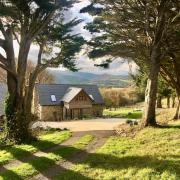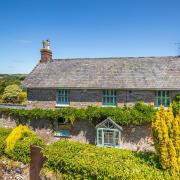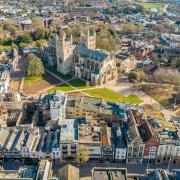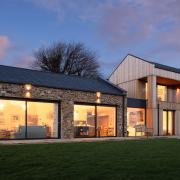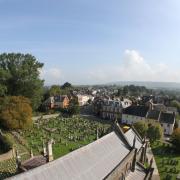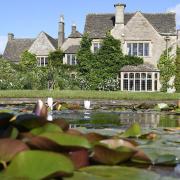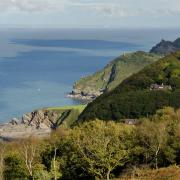A local and national campaign has saved a historic building in Totnes designed by Isambard Kingdom Brunel, one of the finest industrial architects of his age, showing that people power really can work.
Though few locals even know it exists, the Pumping House, situated beside Totnes station, was part of an extraordinary experiment in rail travel.
During the 1840s when railways were being planned, there was some doubt as to whether steam engines would cope with South Devon's hills. Brunel had the idea of an Atmospheric Railway, using a vacuum. Pumping engines along the route sucked air out of a tube, dubbed a 'Rope of Air', between the tracks. The vacuum pulled the train along.
The theory was sound, but the available technology wasn't reliable enough. Brunel planned to extend his Atmospheric Railway to Plymouth but, less than a year after it started running between Exeter and Newton Abbot, the directors of the South Devon Railway pulled the plug without giving the whole system a proper trial. The pumping house in Totnes was mothballed.
The rustic Italianate-style buildings that housed the boilers and engines are rare survivors of an extraordinary chapter in Brunel's life. Atmospheric railway buildings at Starcross and Torquay eventually gained listed building status. Because of an oversight, the Totnes buildings were not listed and simply melted into the 20th-century industrial paraphernalia of a dairy processing plant.
The building under threat
In May 2007, the building's future started to look uncertain. "We heard that Dairy Crest were pulling out of Totnes and selling the site," says Pruw Boswell-Harper, Totnes Town Council's heritage champion. "We realised that, without listing, Brunel's building could be under serious threat."
Dairy Crest wanted to flatten the pumping house to realise the potential market value of the site. Three groups, including the Town Council, made applications to English Heritage, but were disappointed. "English Heritage said the building wasn't intact, though it is," says Pruw. "They saw the Atmospheric Railway as a failure."
This last point particularly irritated Dr Mark Horton, a presenter on BBC 2's Coast programme and reader in archaeology at the University of Bristol. "If you only preserve technological successes you're literally whitewashing history," he says. "When electric railways came in towards the end of that century, power was supplied from the track side through a central rail, a direct successor of the Atmospheric Principle."
Pruw and her colleagues appealed against the decision to the Department of Culture, Media and Sport (DCMS). In mid-February they were told they had been refused again for the same reasons. "They had simply gone back to English Heritage rather than review the situation independently," she complained.
Offers to lie in front of the bulldozers
When the roof tiles started to come off the building, the gloves were also off as far as the local community was concerned. Pruw enlisted the help of Adam Wilkinson, Secretary of Save Britain's Heritage, and local MP Anthony Steen, who tabled a question in the House. She even had offers from locals to "lie down in front of the bulldozers - everyone was involved right across the community and beyond".
Save Britain's Heritage had campaigned to save Brunel's Temple Meads Station in Bristol in the 1970s, so they were very familiar with his illustrious history. Adam Wilkinson says: "We were able to draw on a huge army of experts, from interested locals right through to industrial archaeologists and Brunel historians. They were amazed that a building of this significance was facing any kind of threat. Even though this building was not commissioned, it is still a vital part of Brunel's vision for that line. We put forward the case as forcefully as we could."
Philip Chandler, Editor of totnesonline.com, is one of many who fought the cause from their keyboard. "I contacted the Bristol Industrial Archaeological Society, and they rang as many bells as they could around the archaeological community, including Dr Mark Horton who is a big Brunel fan, and he stirred the pot quite vigorously."
Jeremy Clarkson gets on board
A great deal of pressure was put on English Heritage to change its mind, even Top Gear's lad of culture Jeremy Clarkson got on board; having championed Brunel in BBC's Great Britons series he was suitably acerbic. "Dairy Crest is a jolly big and important company, I'm sure. But its chilled products will never worm their way into the fabric of Britain quite like Isambard Kingdom Brunel did."
Deciding what should and should not be saved for the nation is not an easy task. As Roger Bowdler, Head of Designation at English Heritage, explains, the organisation has to be responsive and receptive to expert claims made by others. "We can't always say yes; we have to weigh up the evidence and advise the Secretary of State accordingly. Because Brunel has a lot of cachet and the building was part of his engineless railway carriage experiment, we had a rethink in the case of this building."
Listing is achieved
DCMS has now give Brunel's building Grade II Listing, so Richard Gage, South Hams District Council's Conservation and Design Officer, will be adding this historic gem to the other 3,500 listed buildings he looks after. "Internally, the really special thing about this building is its glorious roof structure," he enthuses. "Meaty mid-19th-century industrial, those Brunel-esque roof timbers are really quite special." Those listed buildings will influence any future development on the site.
Richard says: "Get the right architects, get the people with vision, get a steer from the local authority and these buildings can really become an integral part of the community. It has so much potential, it's crying out for something special."
Local group The Atmos Project, which is bidding for the site, believes it may well have that special something. Their leader, Nigel Topping, says Brunel's buildings are at the heart of their vision for a sustainability showcase site. "Brunel was of one of Britain's great innovators of the industrial revolution. Now we hope to use the building to show off the work of innovators in sustainable living, which will be the 21st century's revolution."
Let's hope that after 160 years the true potential of Brunel's hidden gem in the heart of Totnes is realised.
HELEN STILES
For more information about The Atmos Project go to www.atmosproject.com
More on Brunel can be found on www.brunel200.com



